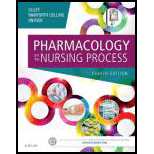
To Compare:
The coagulation process and the impact of coagulation modifier include anticoagulants, antiplatelet, thrombolytic, and antifibrinolytics.
Concept introduction:
Coagulation is otherwise called clotting. In this clotting process, the blood changes to gel from liquid. The forming of blood clot results in hemostasis. Generally, the clotting of blood occurs when the blood vessels are damaged. The protein is the coagulation process that is numbered by the Roman numerals from I- XIII. Some of the coagulation factors are II, VII, IX, and X, where all are produced in the liver except VIII.
Explanation of Solution
Impact of coagulation modifier:
The coagulation modifier is the drug that takes action on the blood coagulation pathway to prevent or develop the formation of a clot. The coagulation modifiers are anticoagulants, antiplatelet drug, and thrombolytic drug.
Anticoagulants:
The anticoagulants prevent the formation of clotting factors and also avoid the formation of clots. The action of anticoagulant varying from one drug to another drug and the anticoagulant therapy are used for treating thrombosis.
Antiplatelet:
The antiplatelet blocks the platelet plugs from forming and preventing platelet aggregations. This process can be helpful in avoiding heart attack and strokes. Some of the antiplatelets include clopidogrel, dipyridamole, and ticlopidine.
Thrombolytic drug:
The important difference between thrombolytic and anticoagulant is to prevent the formation of blood clots. The thrombolytic drugs break the clots that are already present in the vessels. The thrombolytic is used as the injection to bust the clots by an intravenous line.
Antifibrinolytics drugs:
The hemostatic drug is otherwise called the antifibrinolytics drug that possesses the opposite effect when compared to the other class of drugs. This is mainly involved in promoting blood coagulation.
Thus, the coagulation modifiers are responsible for promoting or preventing the formation of blood clots.
Want to see more full solutions like this?
Chapter 26 Solutions
Pharmacology and the Nursing Process, 8e
- true or false dark skinned infants should be screened for vitamin D levelsarrow_forwardtrue or false any practice employee is authorized to and should communicate collection guidelines with practice?arrow_forwardrtrue or false equesting a listing of specific creditreferences during patient intake os an acceptable business practice?arrow_forward
- give an overview on the respiratory assessmentarrow_forwardexplain an abdominal exam?arrow_forwardDiscuss β -Lactam antibiotics under the following subheadings Classifications of penicillins Classification of Cephalosporins General Mechanism of Actions Clinical Indications of penicillins and cephalosporins Adverse effects of β-lactamsarrow_forward
- a. Define neoplasm b. Differentiate between benign and malignant tumours c. Describe the molecular basis of cancerarrow_forwarddifferentiate the extra heart sounds S3,S4, murmurs and gallopsarrow_forward• Define shock and list types of shock • Discuss pathogenesis of septic shock. • Enumerate the stages of shock. • Define oedema and describe the pathophysiologic mechanisms of oedema with examples.arrow_forward
- Discuss Hypertension under the following headings: Definition Diagnosis Non-pharmacological intervention Drugs Classification Management of a Hypertensive emergencyarrow_forwardExplain how the answer could be 2 or 1.8 WITHOUT changing the questionarrow_forwardoverview of the neurological system, cranial nerves and what part of the body it innervatesarrow_forward
 Phlebotomy EssentialsNursingISBN:9781451194524Author:Ruth McCall, Cathee M. Tankersley MT(ASCP)Publisher:JONES+BARTLETT PUBLISHERS, INC.
Phlebotomy EssentialsNursingISBN:9781451194524Author:Ruth McCall, Cathee M. Tankersley MT(ASCP)Publisher:JONES+BARTLETT PUBLISHERS, INC. Gould's Pathophysiology for the Health Profession...NursingISBN:9780323414425Author:Robert J Hubert BSPublisher:Saunders
Gould's Pathophysiology for the Health Profession...NursingISBN:9780323414425Author:Robert J Hubert BSPublisher:Saunders Fundamentals Of NursingNursingISBN:9781496362179Author:Taylor, Carol (carol R.), LYNN, Pamela (pamela Barbara), Bartlett, Jennifer L.Publisher:Wolters Kluwer,
Fundamentals Of NursingNursingISBN:9781496362179Author:Taylor, Carol (carol R.), LYNN, Pamela (pamela Barbara), Bartlett, Jennifer L.Publisher:Wolters Kluwer, Fundamentals of Nursing, 9eNursingISBN:9780323327404Author:Patricia A. Potter RN MSN PhD FAAN, Anne Griffin Perry RN EdD FAAN, Patricia Stockert RN BSN MS PhD, Amy Hall RN BSN MS PhD CNEPublisher:Elsevier Science
Fundamentals of Nursing, 9eNursingISBN:9780323327404Author:Patricia A. Potter RN MSN PhD FAAN, Anne Griffin Perry RN EdD FAAN, Patricia Stockert RN BSN MS PhD, Amy Hall RN BSN MS PhD CNEPublisher:Elsevier Science Study Guide for Gould's Pathophysiology for the H...NursingISBN:9780323414142Author:Hubert BS, Robert J; VanMeter PhD, Karin C.Publisher:Saunders
Study Guide for Gould's Pathophysiology for the H...NursingISBN:9780323414142Author:Hubert BS, Robert J; VanMeter PhD, Karin C.Publisher:Saunders Issues and Ethics in the Helping Professions (Min...NursingISBN:9781337406291Author:Gerald Corey, Marianne Schneider Corey, Cindy CoreyPublisher:Cengage Learning
Issues and Ethics in the Helping Professions (Min...NursingISBN:9781337406291Author:Gerald Corey, Marianne Schneider Corey, Cindy CoreyPublisher:Cengage Learning





